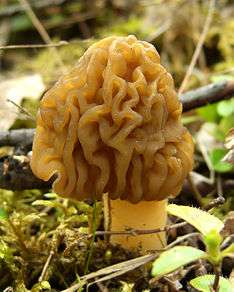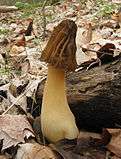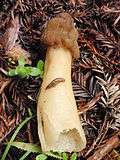Verpa bohemica
Verpa bohemica is a species of fungus in the family Morchellaceae. Commonly known as the early morel (or early false morel) or the wrinkled thimble-cap, it is one of several species known informally as a "false morel". The mushroom has a pale yellow or brown thimble-shaped cap—2 to 4 cm (0.8 to 1.6 in) in diameter by 2 to 5 cm (0.8 to 2.0 in) long—that has a surface wrinkled and ribbed with brain-like convolutions. The cap hangs from the top of a lighter-colored, brittle stem that measures up to 12 cm (4.7 in) long by 1 to 2.5 cm (0.4 to 1.0 in) thick. Microscopically, the mushroom is distinguished by its large spores, typically 60–80 by 15–18 µm, and the presence of only two spores per ascus.
| Verpa bohemica | |
|---|---|
 | |
| Scientific classification | |
| Kingdom: | |
| Division: | |
| Class: | |
| Order: | |
| Family: | |
| Genus: | |
| Species: | V. bohemica |
| Binomial name | |
| Verpa bohemica | |
| Synonyms[1] | |
| |
| Verpa bohemica | |
|---|---|
float | |
| smooth hymenium | |
| cap is convex | |
| hymenium attachment is not applicable | |
| stipe is bare | |
| spore print is yellow | |
| ecology is saprotrophic | |
| edibility: edible but not recommended | |
In the field, the mushroom is reliably distinguished from the true morels on the basis of cap attachment: V. bohemica has a cap that hangs completely free from the stem. Although widely considered edible, some attention should be paid to the correct preparation. Consumption of the mushroom, not correctly prepared lead to reports of poisoning in susceptible individuals. Poisoning symptoms include gastrointestinal upset and lack of muscular coordination. V. bohemica is found in northern North America, Europe, and Asia. It fruits in early spring, growing on the ground in woods following the snowmelt, before the appearance of "true morels" (genus Morchella). The synonym Ptychoverpa bohemica is often used by European mycologists.
Taxonomy, phylogeny, and naming
The species was first described in the scientific literature by the Czech physician and mycologist Julius Vincenz von Krombholz in 1828, under the name Morchella bohemica.[2] The German naturalist Joseph Schröter transferred it to the genus Verpa in 1893.[3] Ptychoverpa bohemica is a synonym that was published by Frenchman Jean Louis Émile Boudier in his 1907 treatise on the Discomycetes of Europe;[4] the name is still occasionally used, especially in European publications.[5] Boudier believed that the large, curved ascospores and the rare and short paraphyses were sufficiently distinct to warrant a new genus to contain the single species.[4][6] Ptychoverpa has also been classified as a section of Verpa.[7] The section is characterized by the presence of thick longitudinal ridges on the cap that can be simple or forked.[8] The species was first discovered in Canada by Alfred Brooker Klugh shortly before 1910[9] where it was referred to by another synonym, Morchella bispora.[10][11]
The specific epithet bohemica refers to Bohemia (now a part of the Czech Republic),[12] where Krombholz originally collected the species.[2] The mushroom is commonly known as the "early morel",[13] "early false morel", or the "wrinkled thimble-cap".[14] Ptychoverpa is derived from the Ancient Greek ptyx (genitive form ptychos), meaning "fold", layer", or "plate".[15]
Description


The cap of this fungus (known technically as an apothecium) is 2 to 4 cm (0.8 to 1.6 in) in diameter by 2 to 5 cm (0.8 to 2.0 in) long, with a conical or bell shape. It is folded into longitudinal ridges that often fuse together (anastomose) in a vein-like network. The cap is attached to the stem at the top only—hanging from the top of the stipe, with the lobed edge free from the stem—and varies in color from yellowish brown to reddish brown; the underside of the cap is pale. The stem is 6 to 12 cm (2.4 to 4.7 in) long by 1 to 2.5 cm (0.4 to 1.0 in) thick, cream-white in color, and tapers upward so that the stem is thicker at the base than at the top.[16] Although the stem is initially loosely stuffed with cottony hyphae, it eventually becomes hollow in maturity; overall, the mushroom is rather fragile.[17] The spore deposit is yellow, and the flesh is white.[18]
Relative to other typical mushroom species, the spores of V. bohemica are huge, typically measuring 60–80 by 15–18 µm. They are elliptical, smooth, sometimes curved, and appear hyaline (translucent) to yellowish.[16] The spores, which number two (more rarely three)[19] per ascus are characteristic for this species.[13] The smooth, elliptical asci measure 275–350 µm long by 16–23 µm wide.[20] The British-Canadian mycologist Arthur Henry Reginald Buller determined that the asci are heliotropic—they bend toward light. As he noted, "I cut transverse sections though their pilei, examined these sections under the microscope, and at once perceived that in all the hymenial grooves and depressions the asci were curved outwards so that their opercula must have faced the strongest rays of light to which the ends of the asci has been subjected in the places where the fruit-bodies developed."[21] This response to the stimulus of light is significant because it permits a fruit body to point and later discharge its asci towards open spaces, thus increasing the chances that the spores will be dispersed by wind.[21] The paraphyses are thick and club-shaped, with diameters of 7–8 µm at their tips.[22]
Edibility
In Russia Verpa bohemica is a commercial species. It is usually sold frozen. No clinical cases have been registered within the Russian Federation concerning intoxications to this mushroom up to date. Despite that, the edibility of this species has been source of different opinions. Although Verpa bohemica is eaten by many, consumption of large amounts in a single sitting, or on successive days, has been reported to cause poisoning in susceptible individuals.[23] Symptoms include gastrointestinal upset and lack of muscular coordination, similar to the effects reported by some individuals after consuming the false morel species Gyromitra esculenta.[19] The responsible toxin in G. esculenta is gyromitrin; it was suspected that V. bohemica may be able to synthesize low levels of the toxin,[24] however, no experiments on V. bohemica have concluded that it contains any level of gyromitrin.[25] Over-consumption of the mushroom has been reported to have induced a coma.[26] Those who do wish to eat this species are often advised to parboil with copious quantities of water (discarding the water before consumption),[27] to dry the specimens before eating,[28] or, if eating for the first time, to restrict consumption to small portions to test their tolerance.[13] Some advocate only eating the caps and discarding the stems.[29] Opinions on the flavor of the mushrooms vary, ranging from "strong but not on a par with true morels",[30] to "pleasant",[18] to "not distinctive".[5]
Similar species


The closely related species Verpa conica typically has a smooth cap, although specimens with wrinkled caps are known. V. conica may be distinguished microscopically by its eight-spored asci.[30] Its North American range extends much further south than V. bohemica.[20] Another similar group of species are the "half-free" morels, Morchella semilibera and others, which have a honeycombed cap that is attached to the stalk for about half of its length, and with ridges that are darker than the pits. Additionally, a cross-sectioned stem of a specimen of M. semilibera is hollow, while V. bohemica usually has cottony wisps in the stem,[5] and M. semilibera usually has vertical perforations near the base, while V. bohemica lacks them. Verpa bohemica may be reliably distinguished from all similar species by its much larger spores.[31]
Ecology, habitat and distribution
The fruit bodies of V. bohemica grow singly or scattered on the ground in woods in early spring, often before the appearance of the morel, and throughout the morel season.[5] It is often found along riverbanks, near cottonwoods, willows and aspens, often buried in plant litter.[14] The fungus prefers to fruit in moist areas with ample sunlight.[32] Its minimum growth temperature is 3 °C (37 °F), with an optimum of 22 °C (72 °F), and a maximum of about 30 °C (86 °F).[33] A study of carbon and nitrogen isotope ratios indicated that Verpa bohemica is saprobic, that is, obtaining nutrients from decomposing organic matter.[34] It has been suggested, however, that the fungus is mycorrhizal for at least part of its life cycle.[35] The fungus has a wide distribution throughout northern North America;[5] its range extends south to the Great Lakes in the Midwestern United States, and south to northern California on the West Coast.[20] In Europe, the fungus is widely distributed, and has been collected from Austria,[36] the Czech Republic,[37] Denmark,[36] Finland,[38] Germany,[39] Norway,[40] Poland,[41] Russia,[42] Slovenia,[36] Spain,[36] Sweden,[43] and the Ukraine.[44] In Asia, it has been recorded from India[45] and Turkey.[46]
A 10-year study of the distribution, time of fruiting and habitats of morel and false morel population in Iowa showed that early false morels are the first morels to fruit in the spring, appearing shortly after leaves begin to form on deciduous trees. Narrow-head morels (Morchella angusticeps) fruit next, followed by the yellow or white morels (Morchella esculenta), then lastly Morchella crassipes.[47] The fruit bodies serve as a habitat for breeding dipterans (flies), including Porricondyla media, Pegomya geniculata, and Trichocera annulata.[48]
References
- "Verpa bohemica (Krombh.) J. Schröt. 1893". MycoBank. International Mycological Association. Retrieved 2010-12-27.
- von Krombholz JV. (1831). "Böhmische Morchel, ganz offene Morchel. — Morchella bohemica. KRLZ. böhm. Kačenky". Naturgetreue Abbildungen und Beschreibungen der Essbaren, Schädlichen und Verdächtigen Schwämme (1): 3–5.
- Schröter J. (1893). Kryptogamen-Flora von Schlesien [Cryptogamic flora of Silesia] (in German). 3-2(7). Breslau, Germany: J.U. Kern's Verlag. p. 25.
- Boudier JLÉ. (1907). Histoire et Classification des Discomycètes d'Europe (in French). Paris, France: Klincksieck. p. 34.
- Kuo M. (January 2005). "Verpa bohemica". MushroomExpert.Com. Retrieved 2011-05-03.
- Boudier É. (1892). "Note sur les Morchella Bohemica Kromb. et voisons". Bulletin de la Société Mycologique de France (in French). 8: 141–4.
- Underwood L. (1892). "North American Helvellales". Minnesota Botanical Studies. Reports of the Survey. Botanical Series II: 485.
- Underwood LM. (1899). Moulds, Mildews, and Mushrooms; A Guide to the Systematic Study of the Fungi and Mycetozoa and their Literature. New York, New York: H. Holt. p. 65.
- Estey, Ralph H (1994). Essays on the Early History of Plant Pathology and Mycology in Canada. p. 264. ISBN 9780773564404.
- "Morchella bispora". Mycobank. Retrieved 27 April 2018.
- "Morchella bispora". Index Fungorum. Retrieved 27 April 2018.
- Smith AH, Weber NS (1980). The Mushroom Hunter's Field Guide. Ann Arbor, Michigan: University of Michigan Press. p. 38. ISBN 0-472-85610-3.
- McKnight VB, McKnight KH (1987). A Field Guide to Mushrooms, North America. Boston, Massachusetts: Houghton Mifflin. p. 42. ISBN 0-395-91090-0.
- Ammirati JF, McKenny M, Stuntz DE (1987). The New Savory Wild Mushroom. Seattle, Washington: University of Washington Press. p. 214. ISBN 0-295-96480-4.
- Scarborough J. (1992). Medical and Biological Terminologies: Classical Origins. Norman, Oklahoma: University of Oklahoma Press. p. 74. ISBN 978-0-8061-3029-3.
- Healy RA, Huffman DR, Tiffany LH, Knaphaus G (2008). Mushrooms and Other Fungi of the Midcontinental United States (Bur Oak Guide). Iowa City, Iowa: University of Iowa Press. p. 295. ISBN 978-1-58729-627-7.
- Schalkwijk-Barendsen HME. (1991). Mushrooms of Western Canada. Edmonton, Alberta: Lone Pine Publishing. p. 178. ISBN 0-919433-47-2.
- Phillips R. "Verpa bohemica". Rogers Plants Ltd. Retrieved 2011-05-03.
- Horgen PA, Ammirati JF, Traquair JA (1985). Poisonous Mushrooms of the Northern United States and Canada. Minneapolis, Minnesota: University of Minnesota Press. p. 337. ISBN 0-8166-1407-5.
- Kuo M. (2005). Morels. Ann Arbor, Michigan: The University of Michigan Press. pp. 184–5. ISBN 0-472-03036-1.
- Buller AHR. (1958). Researches on Fungi. 6. New York, New York: Hafner Publishing. pp. 323–4.
- Seaver FJ. (1942). The North American cup-fungi (Operculates) (Supplement ed.). New York, New York: Self published. p. 244.
- Orr DB, Orr RT (1979). Mushrooms of Western North America. Berkeley, California: University of California Press. p. 36. ISBN 0-520-03656-5.
- Lincoff G, Mitchel DH (1977). Toxic and Hallucinogenic Mushroom Poisoning: a Handbook for Physicians and Mushroom Hunters. New York, New York: Van Nostrand Reinhold. p. 171. ISBN 978-0-442-24580-1.
- http://www.fungimag.com/spring-2015-articles/Early%20Morels%20LR.pdf
- Maybrier M, Maybrier M. (2011). Morel Hunting. Mechanicsburg, Pennsylvania: Stackpole Books. p. 18. ISBN 978-0-8117-0834-0.
- Hall IR. (2003). Edible and Poisonous Mushrooms of the World. Portland, Oregon: Timber Press. ISBN 0-88192-586-1.
- Sept JD. (2006). Common Mushrooms of the Northwest: Alaska, Western Canada & the Northwestern United States. Sechelt, British Columbia: Calypso Publishing. p. 82. ISBN 0-9739819-0-3.
- Pelouch M, Pelouch L (2008). How to Find Morels. Ann Arbor, Michigan: University of Michigan Press. p. 71. ISBN 978-0-472-03274-7.
- Arora D. (1986). Mushrooms Demystified: A Comprehensive Guide to the Fleshy Fungi. Berkeley, California: Ten Speed Press. p. 794. ISBN 0-89815-169-4.
- Bessette A, Fischer DH (1992). Edible Wild Mushrooms of North America: a Field-to-Kitchen Guide. Austin, Texas: University of Texas Press. p. 137. ISBN 0-292-72080-7.
- Skirgiello A. (1967). "Materiały do poznania rozmieszczenia geograficznego grzybów wyższych w Europie. II" [Contribution to the knowledge of geographical distribution of higher fungi in Europe: II]. Acta Mycologica (in Polish). 3: 243–9.
- Gilman JC. (1916). "Cabbage yellow and the relation of temperature to its occurrence". Annals of the Missouri Botanical Garden. 3 (1): 25–84 (see p. 55). doi:10.2307/2990072. JSTOR 2990072.
- Hobbie EA, Weber NS, Trappe JM (2001). "Mycorrhizal vs saprotrophic status of fungi: the isotopic evidence". New Phytologist. 150 (3): 601–10. doi:10.1046/j.1469-8137.2001.00134.x.
- Kuo M. (2007). 100 Edible Mushrooms. Ann Arbor, Michigan: The University of Michigan Press. ISBN 978-0-472-03126-9.
- "Species: Ptychoverpa bohemica (Krombh.) Boud. 1907". Global Biodiversity Information Facility. Retrieved 2011-06-17.
- Svrček M. (1981). "Katalog operkulátních diskomycetů (Pezizales) Československa II. (O-W)" [List of operculate discomycetes Pezizales recorded from Czechoslovakia 2. O-W]. Ceska Mykologie (in Czech). 35 (2): 64–89.
- Granmo A, Skifte O, Nilssen AC (1982). "Ptychoverpa bohemica Pezizales in Norway and Finland". Karstenia. 22 (2): 43–8. doi:10.29203/ka.1982.214. ISSN 0453-3402.
- O'Donnell K, Cigelnik E, Weber NS, Trappe JM (1997). "Phylogenetic relationships among ascomycetous truffles and the true and false morels inferred from 18S and 28S ribosomal DNA sequence analysis". Mycologia. 89 (1): 48–65. doi:10.2307/3761172. JSTOR 3761172. Archived from the original on 2016-01-24. Retrieved 2011-06-04.
- Often A, Torkelsen AE (1990). "Ptychoverpa bohemica new record found in South Norway". Blyttia (in Norwegian). 48 (4): 173–5. ISSN 0006-5269.
- Skirgiello A. (1960). "Discomycètes de printemps de Bialowieza" [Spring Discomycetes of Bialowieza]. Monographiae Botanicae (in French). 10 (2): 3–19.
- Skryabina AA. (1975). "Fructification of some species of edible fungi from the family Helvellaceae in the Slobodsky Roan of the Kirov Oblast". Rastitel'nye Resursy. 11 (4): 552–5. ISSN 0033-9946.
- Ryman S. (1978). "Swedish Pezizales of spring and early summer". Svensk Botanisk Tidskrift (in Swedish). 72 (4): 327–40. ISSN 0039-646X.
- Minter DW, Hayova VP, Minter TJ, Tykhonenko YY. (eds). "Verpa bohemica (Krombh.) J. Schröt". Electronic Distribution Maps of Ukrainian Fungi. Archived from the original on 2011-09-27. Retrieved 2011-05-06.CS1 maint: multiple names: authors list (link) CS1 maint: extra text: authors list (link)
- Wani W, Pala SA, Boda RH, Mir RA (2010). "Morels in Southern Kashmir Himalya". Journal of Mycology and Plant Pathology. 40 (4): 540–6. ISSN 0971-9393.
- Dogan HH, Ozturk C, Kasik G, Aktas S (2007). "Macrofungi distribution of Mut province in Turkey". Pakistan Journal of Botany. 39 (1): 293–308. ISSN 0556-3321.
- Tiffany LJ, Knaphaus G, Huffman DM (1998). "Distribution and ecology of the morels and false morels of Iowa". Journal of the Iowa Academy of Science. 105 (1): 1–15. Archived from the original (abstract) on 2012-08-29.
- Krivosheina NP. (2008). "Macromycete fruit bodies as a habitat for dipterans (Insecta, Diptera)". Entomological Review. 88 (7): 778–92. doi:10.1134/S0013873808070038.
External links
| Wikimedia Commons has media related to Verpa bohemica. |